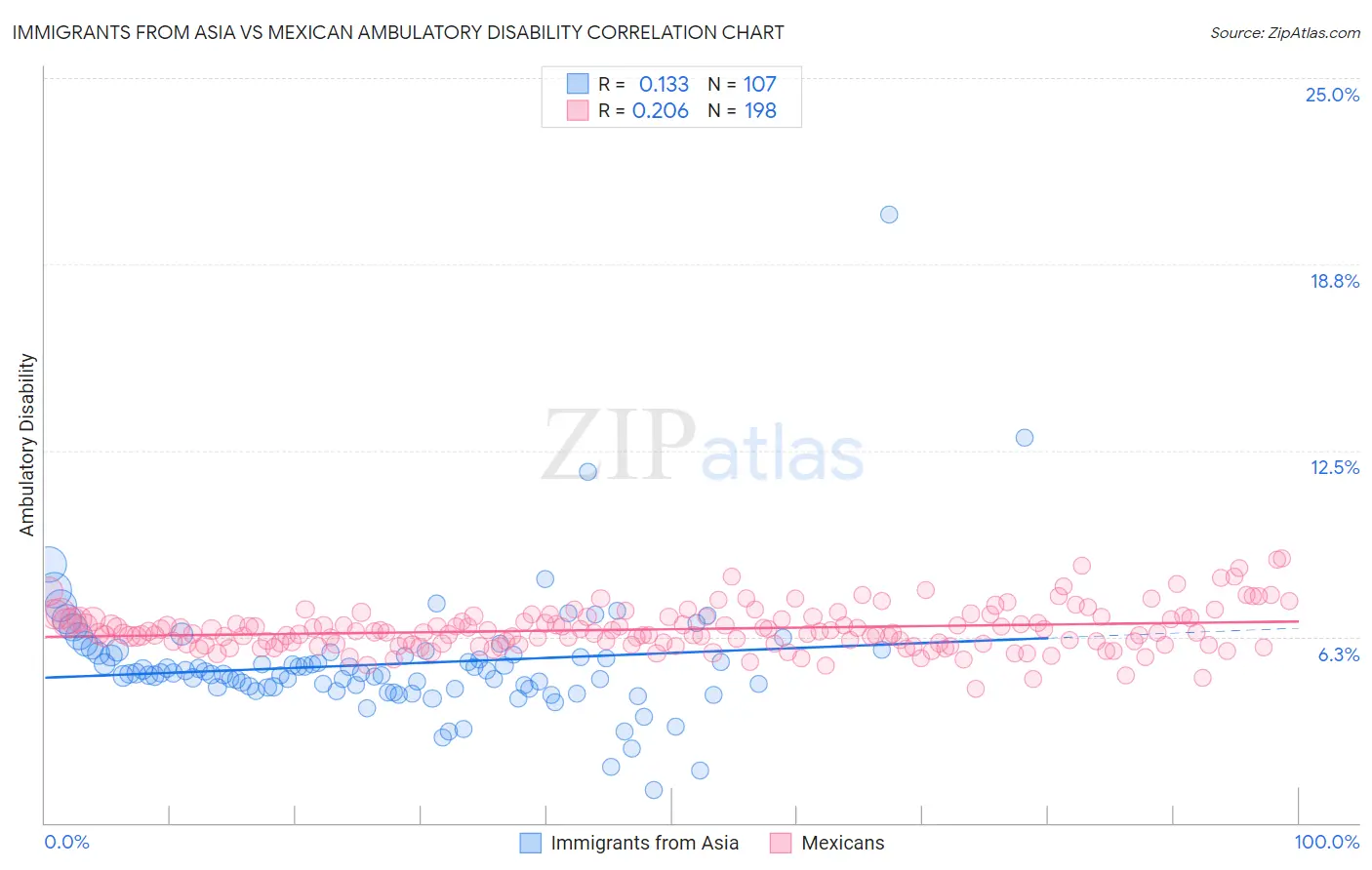Immigrants from Asia vs Mexican Ambulatory Disability
COMPARE
Immigrants from Asia
Mexican
Ambulatory Disability
Ambulatory Disability Comparison
Immigrants from Asia
Mexicans
5.5%
AMBULATORY DISABILITY
100.0/ 100
METRIC RATING
34th/ 347
METRIC RANK
6.4%
AMBULATORY DISABILITY
3.5/ 100
METRIC RATING
230th/ 347
METRIC RANK
Immigrants from Asia vs Mexican Ambulatory Disability Correlation Chart
The statistical analysis conducted on geographies consisting of 548,709,972 people shows a poor positive correlation between the proportion of Immigrants from Asia and percentage of population with ambulatory disability in the United States with a correlation coefficient (R) of 0.133 and weighted average of 5.5%. Similarly, the statistical analysis conducted on geographies consisting of 564,662,817 people shows a weak positive correlation between the proportion of Mexicans and percentage of population with ambulatory disability in the United States with a correlation coefficient (R) of 0.206 and weighted average of 6.4%, a difference of 16.7%.

Ambulatory Disability Correlation Summary
| Measurement | Immigrants from Asia | Mexican |
| Minimum | 1.1% | 4.5% |
| Maximum | 20.4% | 8.9% |
| Range | 19.3% | 4.4% |
| Mean | 5.3% | 6.5% |
| Median | 5.0% | 6.4% |
| Interquartile 25% (IQ1) | 4.5% | 6.0% |
| Interquartile 75% (IQ3) | 5.6% | 6.9% |
| Interquartile Range (IQR) | 1.1% | 0.88% |
| Standard Deviation (Sample) | 2.1% | 0.72% |
| Standard Deviation (Population) | 2.1% | 0.72% |
Similar Demographics by Ambulatory Disability
Demographics Similar to Immigrants from Asia by Ambulatory Disability
In terms of ambulatory disability, the demographic groups most similar to Immigrants from Asia are Afghan (5.5%, a difference of 0.040%), Immigrants from Malaysia (5.5%, a difference of 0.11%), Turkish (5.5%, a difference of 0.13%), Cypriot (5.5%, a difference of 0.13%), and Immigrants from Pakistan (5.5%, a difference of 0.16%).
| Demographics | Rating | Rank | Ambulatory Disability |
| Asians | 100.0 /100 | #27 | Exceptional 5.4% |
| Cambodians | 100.0 /100 | #28 | Exceptional 5.4% |
| Immigrants | Iran | 100.0 /100 | #29 | Exceptional 5.4% |
| Immigrants | Turkey | 100.0 /100 | #30 | Exceptional 5.4% |
| Immigrants | Venezuela | 100.0 /100 | #31 | Exceptional 5.4% |
| Immigrants | Australia | 100.0 /100 | #32 | Exceptional 5.5% |
| Immigrants | Pakistan | 100.0 /100 | #33 | Exceptional 5.5% |
| Immigrants | Asia | 100.0 /100 | #34 | Exceptional 5.5% |
| Afghans | 100.0 /100 | #35 | Exceptional 5.5% |
| Immigrants | Malaysia | 100.0 /100 | #36 | Exceptional 5.5% |
| Turks | 100.0 /100 | #37 | Exceptional 5.5% |
| Cypriots | 100.0 /100 | #38 | Exceptional 5.5% |
| Immigrants | Eritrea | 100.0 /100 | #39 | Exceptional 5.5% |
| Venezuelans | 99.9 /100 | #40 | Exceptional 5.5% |
| Mongolians | 99.9 /100 | #41 | Exceptional 5.5% |
Demographics Similar to Mexicans by Ambulatory Disability
In terms of ambulatory disability, the demographic groups most similar to Mexicans are Czechoslovakian (6.4%, a difference of 0.11%), Portuguese (6.4%, a difference of 0.15%), Panamanian (6.4%, a difference of 0.16%), Cuban (6.4%, a difference of 0.17%), and Slavic (6.4%, a difference of 0.49%).
| Demographics | Rating | Rank | Ambulatory Disability |
| Immigrants | Honduras | 7.6 /100 | #223 | Tragic 6.3% |
| Liberians | 7.1 /100 | #224 | Tragic 6.3% |
| Hondurans | 6.3 /100 | #225 | Tragic 6.3% |
| Slavs | 5.1 /100 | #226 | Tragic 6.4% |
| Cubans | 4.0 /100 | #227 | Tragic 6.4% |
| Portuguese | 4.0 /100 | #228 | Tragic 6.4% |
| Czechoslovakians | 3.8 /100 | #229 | Tragic 6.4% |
| Mexicans | 3.5 /100 | #230 | Tragic 6.4% |
| Panamanians | 3.1 /100 | #231 | Tragic 6.4% |
| Assyrians/Chaldeans/Syriacs | 2.4 /100 | #232 | Tragic 6.4% |
| Sub-Saharan Africans | 2.3 /100 | #233 | Tragic 6.4% |
| Immigrants | Liberia | 2.3 /100 | #234 | Tragic 6.4% |
| Hispanics or Latinos | 2.2 /100 | #235 | Tragic 6.4% |
| Dutch | 2.0 /100 | #236 | Tragic 6.4% |
| Immigrants | Germany | 1.8 /100 | #237 | Tragic 6.4% |